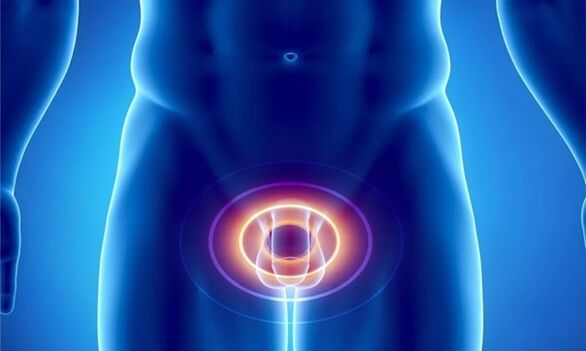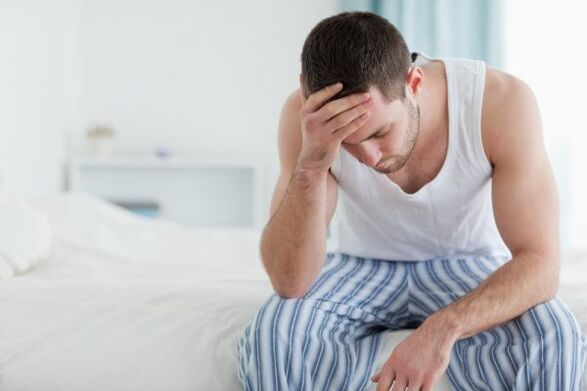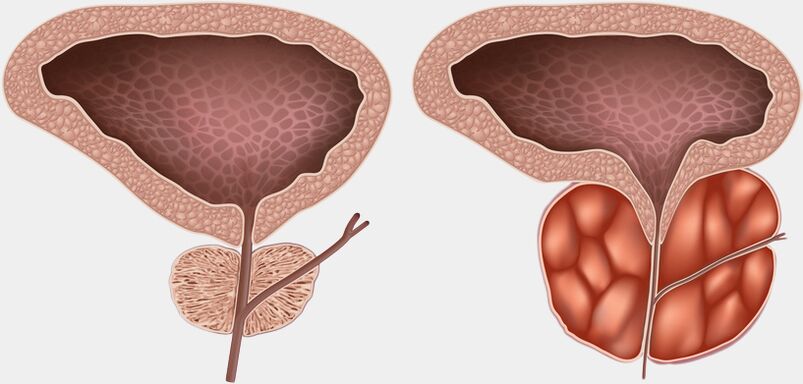
The prostate plays an important role in the functioning of the male body - it normalizes the existence of sperm, dilutes sperm and participates in the regulation of hormone levels.
Today, prostatitis in men is quite common, according to statistics - 30% of men aged 30-55 years suffer from this pathology, which is an inflammatory phenomenon in the prostate gland.
Forms of prostatitis
Specialists distinguish several types of pathology:
- Chronic bacterial - a chronic type of pathology provoked by a bacterial infection;
- Chronic bacterial - a chronic inflammatory process created by non-infectious causes;
- Acute form of pathology - attacks of chronic pain, concentrated in the genital area;
- The asymptomatic form of pathology is difficult to determine, usually only after regular preventive examinations.
Signs of developing prostatitis
How does prostatitis manifest itself? Doctors usually identify 6 signs that predict prostatitis. If a man has noticed at least 2 signs from this list, then he should definitely consult a doctor:
- Slightly falling flow of urine with a short range;
- Difficulty urinating;
- Painful phenomena during urination;
- Duration of urination, spraying of urine, intermittent flow;
- Partial emptying of the bladder;
- Frequent urge to urinate, especially at night.
The doctor will always be able to determine the first signs of prostatitis in men and treatment after diagnosis will be carried out in a timely manner, with a positive result.
Causes of pathology
Experts talk about the following reasons for the formation of the disease:
- Weakening of immunity - the protective barriers that prevent the appearance of many viral infections are reduced;
- Infectious processes - viral elements, microbes, bacteria through the blood or lymphatics enter the prostate. A sign of this phenomenon is that the temperature rises with prostatitis;
- Sedentary lifestyle - causes interruption of blood supply, lack of oxygen;
- Circulatory disorders due to stagnant moments in the genital area - occur due to indiscriminate sex life, prolonged abstinence from sexual intercourse, irregular intercourse.
Inflammation in the prostate can begin due to the penetration of microbes, but the development of infection requires pathogenic microflora, which can be created as a result of the following factors - the presence of harmful addictions, constipation, hormonal disorders, trauma, hypothermia and others.
Symptoms of pathology
How does prostatitis manifest itself? Important symptoms indicating the appearance of prostatitis are a difficult process of urination, painful sensations at this time. The frequent desire to empty the bladder in small portions indicates the development of pathology. Therefore, in this situation you should definitely consult a doctor, otherwise the inflammation will change into a chronic structure.
The initial stages of the pathology may be asymptomatic. Acute forms of the disease are much easier to determine - the manifestation of pathology is always sudden, acute. It should be borne in mind that the course of the disease is due to the individual characteristics of each person's body.
The following symptoms of prostatitis are distinguished:
- Painful sensations in the perineal area;
- Rising temperature;
- Excretion is accompanied by painful attacks;
- Potency disorders;
- Frequent urination
- Increased sweating;
- General malaise;
- Feeling of fullness in the bladder;
- Irritability, sudden mood swings;
- Excretory phenomena from the urethra during bowel movements.
Usually only some of the above points appear.
Rising temperature
The development of an acute form of pathology is characterized by intoxication of the body, a febrile state, and the temperature with prostatitis can also reach 40 degrees. Syndromes of the manifested pathology - disorders in the field of urination. Acute type of prostatitis requires timely treatment, otherwise it can lead to negative consequences, to surgery.
Prolonged decision to undergo a medical examination can affect the change of the pathology into a chronic form, with a long period of development, which requires large financial costs for its treatment.
Pain attacks with the development of pathology
The complex structure of prostatitis is accompanied by painful symptoms. Prostatitis pain in men is not characterized by precise localization. In the absence of a treatment process, the pain attacks increase and spread to other genitals. In advanced situations, an acute stage of the disease, adenoma, develops.
It is known that the pain of prostatitis in men is short-lived, long-lasting.
Regular painful attacks lead to an uncomfortable lifestyle, the development of neuroses in men and worsen the quality of life.
Usually the painful sensations occur in the following moments:
- During urination;
- During an erection;
- During sexual intercourse;
- After sexual intercourse;
- During defecation;
- Due to prolonged abstinence or, conversely, indiscriminate sexual intercourse;
- After hypothermia;
- Due to severe physical stress.
The lower back begins to ache when the pathology develops outside the prostate gland. Painful attacks are either dull or sharp. Due to the neglect of the pathology, the painful sensations can last for a long time. That is why it is so important to consult a urologist in a timely manner, as inflammation can spread to the kidneys.

Also, pathologies in the prostate area are characterized by dull or sharp painful attacks in the groin area, rarely in the legs.
Elimination of painful sensations is possible by the following methods:
- Prostate massage;
- Phytotherapeutic treatment;
- Hormonal methods for treating pathology;
- Special diet to normalize a person's condition;
- Antibacterial ways to remove harmful elements;
- Use of adrenergic blockers to relieve urination.
Prostate adenoma or prostatitis?
Prostate adenoma is a benign neoplasm of the prostate gland, usually this pathology is observed in men after 45-50 years. Hormonal imbalance is recognized as an important reason for the formation of pathology - over the years the level of male hormones changes, decreases. There are also risk factors that contribute to the appearance of pathology - obesity, stress, atherosclerosis, harmful addictions.
The manifestation of pathology is pronounced, therefore already in the first stages of its development it is possible to accurately diagnose.
The course of prostate adenoma in men is characterized by forward movement, development, the tumor provokes new clinical moments.
The symptoms of prostate adenoma and prostatitis in the strong half of humanity are similar - often difficulty urinating, burning sensation in the prostate, pain.
The course of prostate adenoma in men depends on the stage of this pathology.
The consequences of prostate adenoma in men are serious - renal failure, cystitis, urolithiasis.
Diagnostic measures
The doctor can identify signs of prostatitis in men and its treatment will be prescribed in a timely manner. To determine prostatitis, it is necessary to consult a urologist, who will conduct an examination and prescribe other important diagnostic procedures:
- Medical examination to compile a general clinical picture;
- Taking urine tests;
- STD detection tests;
- Determining the presence or absence of infections, take a swab from the urethra;
- Ejaculate analysis;
- Ultrasound of the genitals;
- Urography;
- Biopsy - if cancer is suspected.
Using the results of the above processes, the doctor draws up a treatment plan for the disease in a given patient.
Methods of treatment of prostatitis
How to treat this pathology? After diagnosing the disease, the doctor determines the treatment regimen for the pathology, usually using an integrated approach consisting of the following points:
- Antibacterial therapeutic methods - a specialist prescribes a course of treatment, namely antibiotics to eliminate harmful trace elements that lead to prostatitis. They also lower the temperature;
- Physiological influences, for example, with the help of laser, ultrasonic waves, electromagnetic waves.
- Traditional methods of treatment are used - procedures with a hot bath with medicinal herbs;
- The massage is performed in the area of the prostate gland - frees the ducts from stagnation, increases the blood supply to the genitals;
- Herbal medicine - the use of decoctions of useful medicinal herbs, dietary supplements helps to strengthen the immune system, fights infection;
- Psychotherapeutic methods - due to prostatitis, the man develops negative psychological problems, confidence disappears, fears appear during intercourse;
- Surgical treatments are used in advanced and severe stages of pathology development, for example, prostate abscess;
- Correction of the immune system - the doctor may prescribe certain vitamins, minerals, beneficial trace elements to strengthen the patient's immunity;
- Balanced, proper nutrition for prostatitis, abstinence from alcohol, smoking, fatty foods, limiting salt intake, and drinking more plain water - at least 2 liters per day.

Precautions
It is important to monitor your health. To prevent the development of prostatitis, it is necessary to avoid exposure to factors that may lead to its occurrence:
- Do not overcool;
- Eat a balanced, healthy diet;
- Exercise, exercise;
- Have sex with a regular partner, protect yourself from STDs;
- Undergo an annual examination by a urologist for timely diagnosis of the presence or absence of the disease.
























